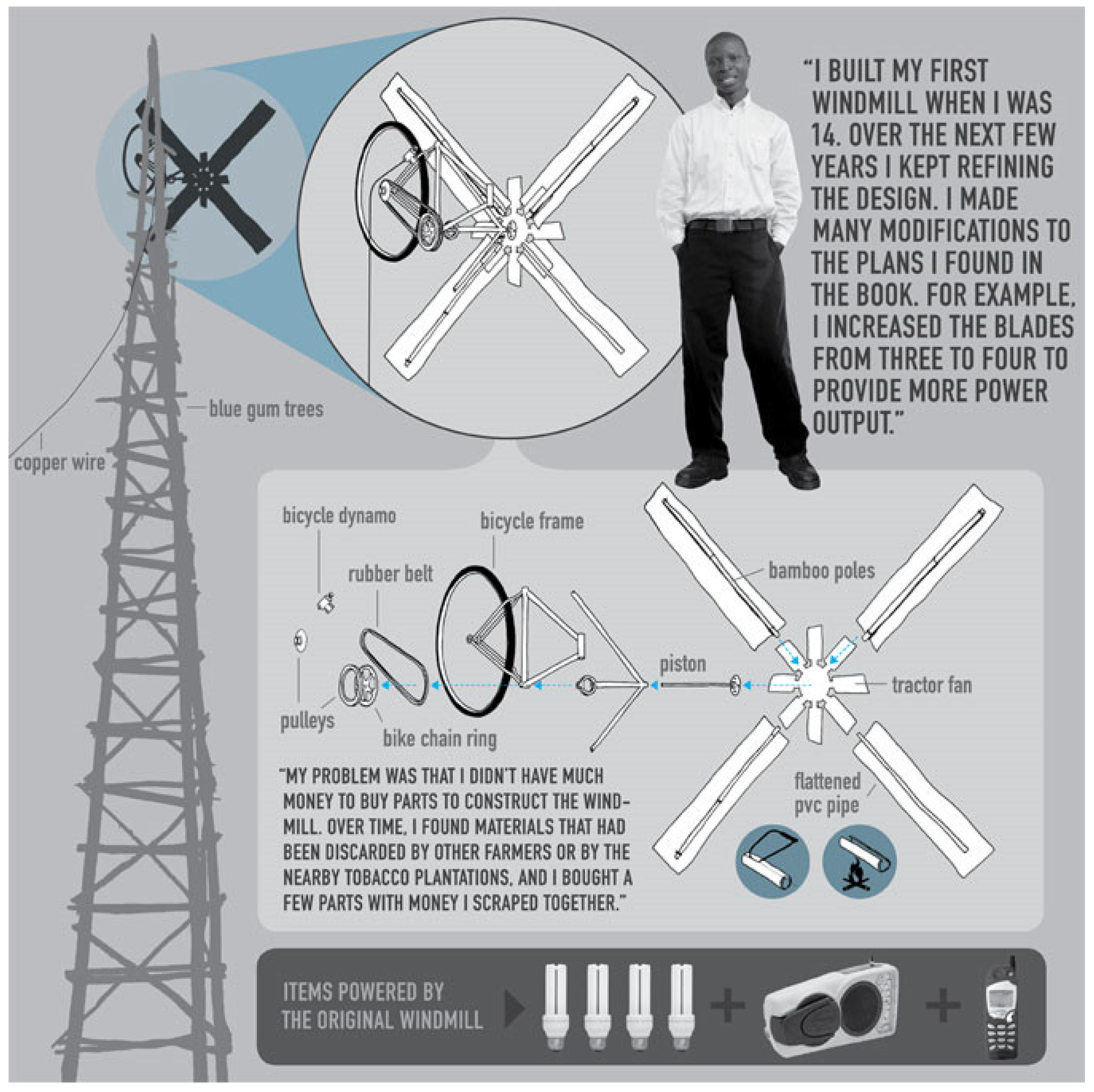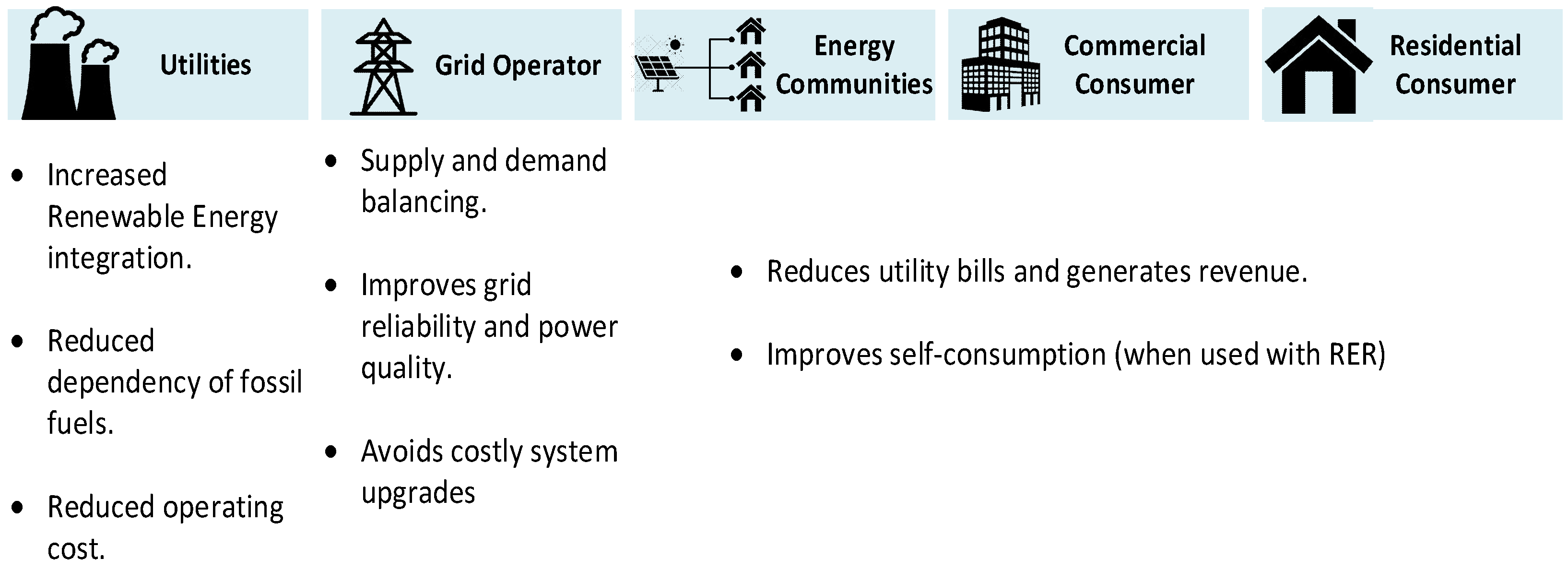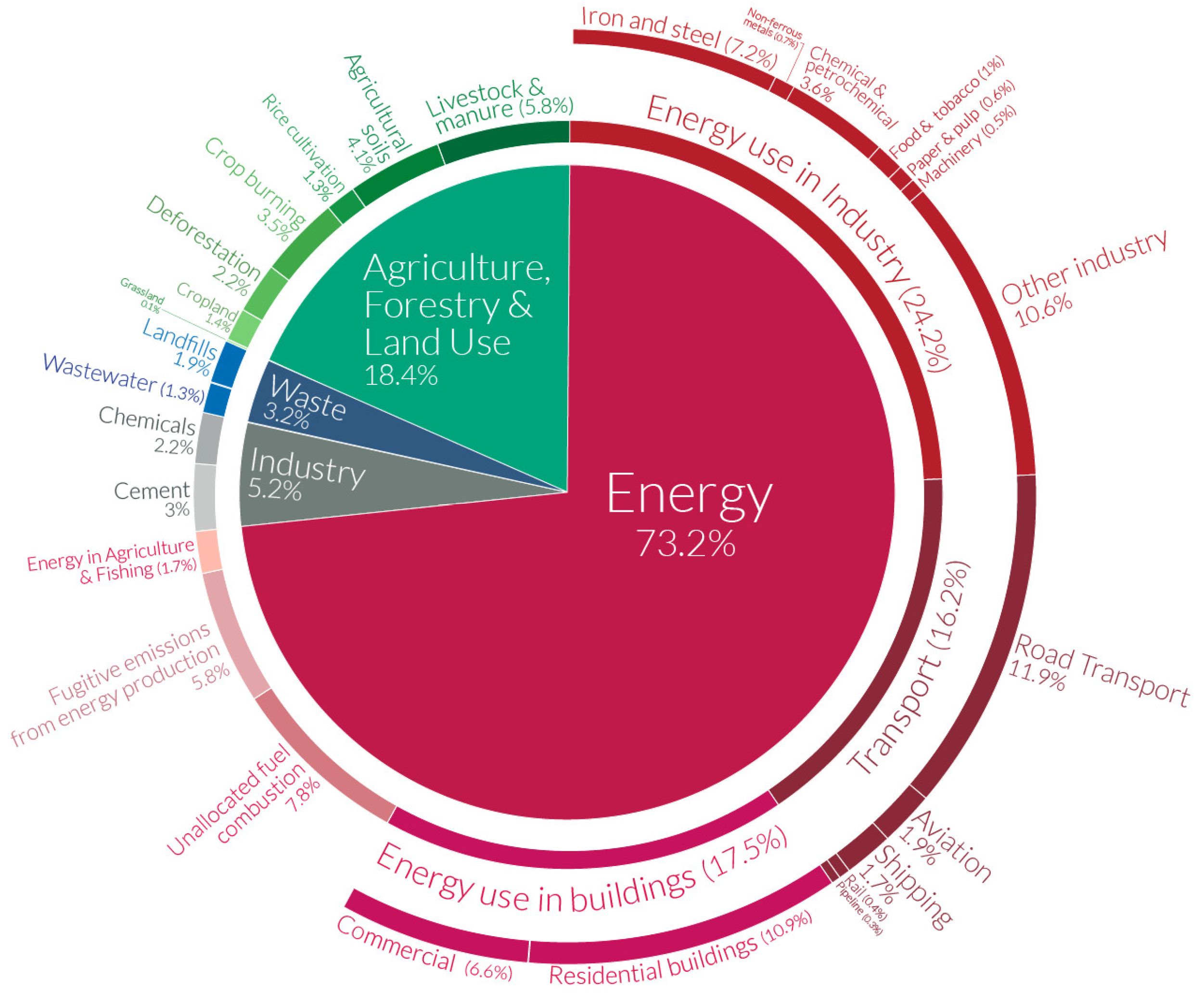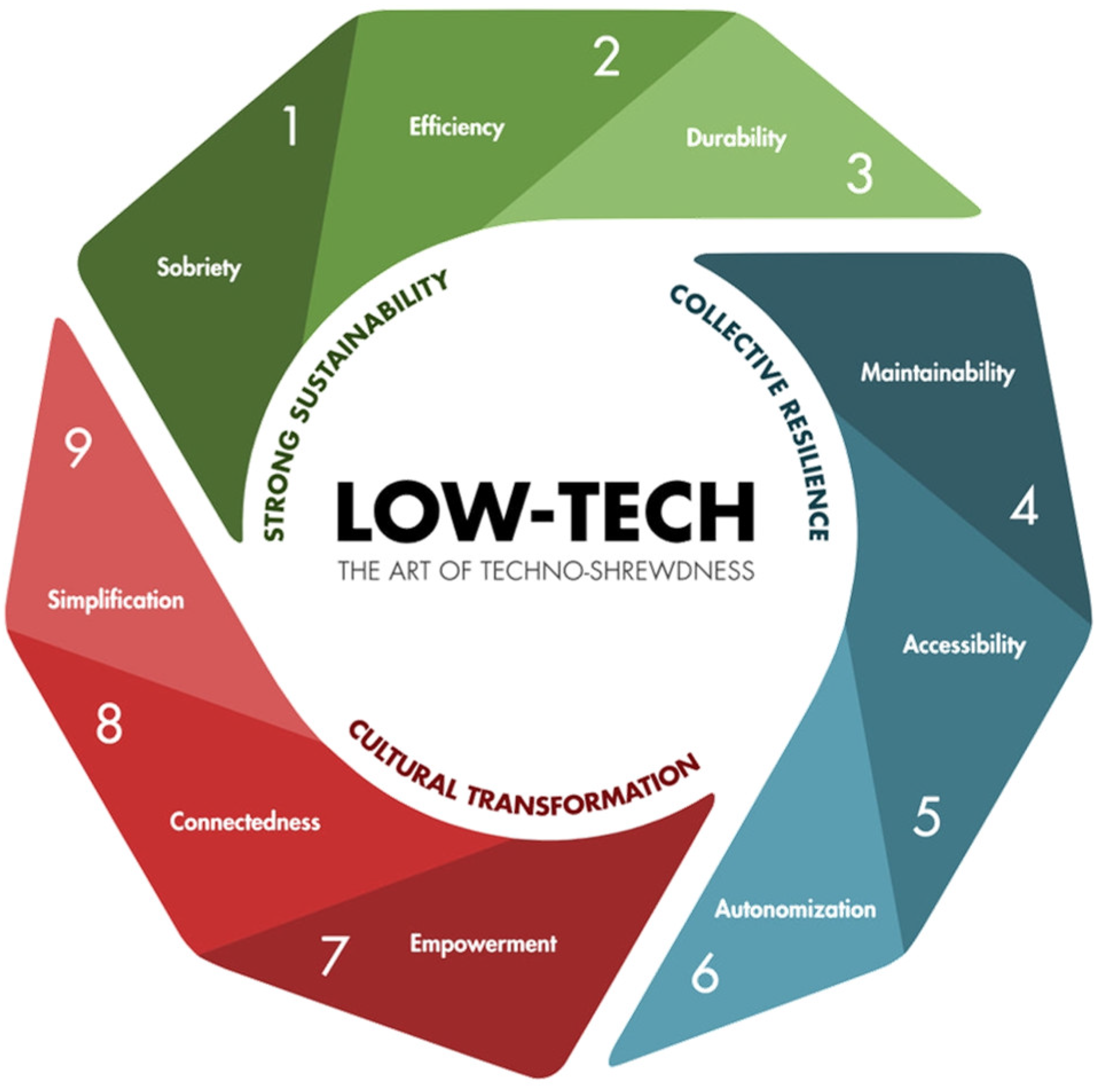You're using an outdated browser. Please upgrade to a modern browser for the best experience.
Please note this is a comparison between Version 2 by Peter Tang and Version 1 by Seun Osonuga.
Energy flexibility, one of the key pillars of the energy transition, is an umbrella term that covers multiple innovative solutions implemented at all levels of the electric grid to ensure power quality standards, amongst other objectives. Low-tech, on the other hand, emphasizes designing, producing, and sustainably implementing solutions that address the core needs of individuals and organisations.
- low-tech
- energy flexibility
- sustainability
- technology selection criteria
- energy transition
- socio-ecological transition
1. Introduction
Faced with the ever-increasing threat of global warming and its predicted catastrophic consequences, institutions, and individuals have committed to strategies aimed at reducing their negative environmental impact. Energy use, in various forms, has been identified as the largest contributor to global warming, as illustrated in Figure 1. Many countries around the world have committed to the energy transition pathway [1,2][1][2]. For example, the EU has adopted the “European Green Deal” as an ambitious plan to transform its current fossil-fuel-dependent energy sector into a sustainable, carbon-free energy sector by the second half of this century (i.e., by 2050) [3]. However, it requires the active participation of all the stakeholders, i.e., governments, businesses, academic researchers, and society.
The active participation of the aforementioned stakeholders is generally referred to as the quadruple helix model of innovation, which was originally conceptualized by Carayannis [4] and Schutz [5]. Amongst these stakeholders, technology serves as a common commodity and, therefore, is a key ingredient for meeting the objectives of the energy transition. However, this energy transition should be implemented vigilantly without compromising the core needs of consumers (i.e., reliable energy supply). By taking into account both technology and the consumer, Illich [6] introduces the concept of a convivial society. This concept is defined as “a society in which modern technologies serve politically interrelated individuals rather than managers”. Illich [6] further postulates that technology can be used in two ways. The first way leads to the specialization of functions, the institutionalization of values, and the centralization of power, consequently turning people into what he termed “machines”. The second approach, on the other hand, improves an individual’s capability, control, and initiative, which he refers to as “conviviality”.
Schumacher [8] further built upon this idea by making a distinction between “man-as-producer” and “man-as-consumer”. It is stated in his work that previous ideologies and concepts did not make this distinction and consequently resulted in the depletion of the earth’s resources. To buttress this point, Schumacher [8] postulates that “there is no escape from this confusion as long as the land and the creatures upon it are looked upon as nothing but ‘factors of production”. Confusion, in this case, refers to the failure to separate “man-as-producer” and “man-as-consumer”. In an attempt to address the misspecification of priorities as identified himself, Schumacher founded the “Intermediate Technology Development Group,” which was a key instrument for the consequent “Appropriate Technology” movement [9].
Based on the initial works of Illich and Schumacher, some technology-innovation-related concepts have emerged over time. These concepts include, but are not limited to:
-
Frugal Innovation: It is defined as a solution designed and implemented under given resource constraints, where the outcome is significantly cheaper than existing solutions and satisfies the basic needs of customers who would otherwise remain underserved or unserved [10,11][10][11]. In summary, it is an attempt to maximize the ratio of the value obtained from the solution to the resources used by the solution [12]. Proponents of this innovation approach argue that it is instrumental in meeting the needs of the human population sustainably [10]. A lot of emphasis is placed on developing economies by looking to strip non-essential elements from solutions. Whilst frugal innovation has emerged as a response to the needs of low-income markets, some frugal solutions have found their way into higher-income markets, mostly through reverse innovation [11] (innovations first developed in emerging economies and subsequently adopted by developed economies [13]). Thus, whilst the concept might stem from and have been directed towards low-income markets, it is not a far-fetched idea for all markets (irrespective of income levels) to adopt the frugal innovation approach.
-
Appropriate Technology: Kaplinsky [9] defines appropriate technology by aligning it with the economics of a community (and, by extension, a country). Appropriate technologies are thus technological solutions that are simple in terms of design and operation, that can be produced on a small scale, are suited to low-income economies, and have a minimal harmful impact on the environment. In other words, it mirrors the neoclassical economic theories that suggest that developed economies would opt for capital-intensive technology, whereas developing economies would rather choose labor-intensive techniques [14]. It has been observed that the reception of appropriate technology by developing countries is not adequate, as it faces hostility from scientists and elites in these countries. These classes of society deem appropriate technology a means of projecting their country as poor and having low productivity [9]. In this context, the appropriate technology movement was considered a deliberate attempt by developed countries to keep developing countries in a perpetual state of underdevelopment [15,16][15][16].
-
Low-Tech: Arthur Keller, a notable proponent of this concept, defines Low-Tech as a category of products, services, processes, or other systems allowing, via a technical, organizational, and cultural transformation, the development of new models of society that integrate, in their fundamental principles, the requirements of strong sustainability and collective resilience [17]. Figure 2 illustrates the fundamental principles governing low-tech as expressed by Arthur Keller. More recently, Tanguy et al. [18] also defined seven key principles of low-tech systems that cut across social, organizational, and technological domains.
Just like frugal innovation and appropriate technology, other nomenclature exists for low-tech, such as slow-tech, wild-tech, easy-tech, and retro-tech. For the sake of convenience, wthe researchers will use the term “low-tech” in the rest of the entry. This term will also cover the terms “frugal innovation” and “appropriate technology”, as the difference in the definitions is very subtle.
Low-tech has been used as a conception tool as well as an evaluation tool for simple problems. On the other hand, energy technologies have been evaluated across multiple aspects, for instance, from a technical, economical, or sustainability perspective. Considering the fact that energy flexibility is one of the key drivers for achieving the set targets of the energy transition, flexibility solutions must be conceived, built, and implemented in a sustainable manner.
2. The Low-Tech Concept
Three characteristics have been identified by the low-tech lab [20] for a solution to be considered low-tech. The low-tech lab (existing since 2013) [20] is a community space dedicated to the fabrication and sharing of low-tech solutions in France. These three key characteristics are usefulness, accessibility, and sustainability. These characteristics are transformed in the form of a concise definition of low-tech, which states that low-tech solutions are “the objects, systems, techniques, services, knowledge, practices, lifestyles, and ways of thinking that are useful, accessible (in terms of comprehension and financing), sustainable, local, and that favor autonomy” [20,21][20][21].2.1. Characteristics of Low-Tech
Low-tech should be based on the simplest available technology and be renewable, sustainable, repairable, and maintainable over time. Additionally, low-tech solutions should encourage and integrate the concept of a circular economy while relying on knowledge-oriented human work [22]. Therefore, the three characteristics identified by the Low-Tech Lab are extended to five by ADEME (Environment and Energy Management Agency) [21] as follows:-
Usefulness: The solution must satisfy the core need of the consumer and contribute to the moderate use of resources;
-
Accessibility: The solution and knowledge related to it should be available, i.e., the barriers to entry have to be minimal or nonexistent, and the knowledge and skills required to support the technology throughout its life cycle should be easy to access and use;
-
Sustainability: The solution must reduce the negative impact on the environment in terms of emissions, material and energy use, and overall adherence to the earth’s physical boundaries. This is also highlighted by usage with an extended life, which reduces the need for replacement;
-
Localness: The solution should be adapted to the context of local communities;
-
Autonomy: The solution should contribute to the ability of the community to address its own needs, and it should only explore external resources in cases of actual local deficits.

-
It is useful as it satisfies the core need: the energy supply of the household;
-
It is made using recycled and repurposed waste materials;
3. Energy Flexibility
With the increased penetration of intermittent renewable energy sources, energy flexibility has become a pertinent topic in energy research. According to Lund et al. [29][28], energy flexibility can be defined as the ability of an energy network to modify its generation or demand in response to external signals. This can include moving the energy consumption around in time, supplying additional energy to meet unexpected changes in demand, or varying consumption patterns according to supply conditions. It is necessary to note the difference between energy supply and energy flexibility. While energy supply can be characterized as all the processes that lead to the provision of energy for a given use case, energy demand is only concerned with the changes made to the use of these energy resources. Another aspect of energy flexibility to keep in mind is its scale, which ranges from the individual consumer/producer scale to the grid scale as discussed below:-
Building scale: At this scale, energy flexibility is mostly demand-side and presents some significance to both the buildings’ users and the electric grid. To illustrate, the electricity grid equilibrium can be improved by modifying the demand profile of a building (especially with advanced building technologies) [30][29]. The adoption of rooftop solar systems presents an opportunity to self-consume and consequently reduce the energy cost (financial and environmental) of a building [31,32][30][31]. Local production would also imply reduced Net Energy Exchange with the Grid (NEEG) [33][32] and would allow for aggregated storage solutions (including vehicle to grid), which would consequently benefit stakeholders at higher levels within the grid [34][33];
-
Community/distribution scale: With the emergence of local energy communities and the widespread adoption of renewable energy resources (RERs), it is possible to further mitigate the effects of a high RER penetration within the larger grid using methods such as collective self-consumption [35][34] and peer-to-peer energy trading [36][35]. Additionally, the presence of storage (both community scale and aggregated) coupled with RERs could imply higher resilience of the network at this scale (islanding in the event of grid fault events);
- The knowledge is accessible as it was locally attained through a library book;
-
Transmission/Utility scale: At this scale, energy flexibility is vital for ensuring that the network delivers electricity that meets regulatory standards. Energy flexibility is also key in determining and regulating the cost of electricity generation (peak shaving, valley filling, etc.) [37][36]The product (i.e., electricity) is sustainable and renewable;
-
The solution is local as it is fabricated with local components;
-
Since it is the prototype, it can be considered autonomous as it nudges toward its large-scale deployment in the local community.
- . Considering the high penetration of RERs and the evolution of the existing grid towards grid 2.0, energy flexibility is a key instrument for congestion management and grid reliability improvement
- [

Low-Tech Need for Energy Flexibility
3.1. Low-Tech Need for Energy Flexibility
Numerous applications for low-tech have been conceived by ADEME as well as many other stakeholders, such as low-tech labs. In a recent report, The Social and Solidarity Economy Lab, a French think tank, explored the application of low-tech to certain aspects of citizen life, such as housing, transport, well-being, and work [41][40]. However, this work, like most other publications on low-tech, focused mostly on societal needs from an individual’s perspective. Consequently, applications geared toward commercial or complex corporate goods and services were rarely discussed. To drive the adoption of low-tech as a widely accepted development philosophy for the 21st century, it is necessary that low-tech be demonstrated to not only be desirable and applicable to individual needs but also add value when used in the development of more complex and commercial systems. Considering the low-tech approach, it is pertinent to pose questions related to the need for the grid, mainly: (i) “Is the electric grid necessary?”, and (ii) “If the grid is warranted, to what extent/scale do we need it?” Bhattacharyya et al. [42][41] address the former question in their works and conclude that, despite not being the ideal solution, grid extension is the more sustainable alternative compared to the alternatives, i.e., off-grid solar home systems and local mini-grids. This conclusion is further highlighted by Coignard et al. [43][42], whose work shows that high-energy self-sufficiency (at the community scale and using energy from solar PV) has its limits. Thus, there needs to be a trade-off between the efficiency gains derived from a grid and the desire for energy self-sufficiency, especially at the lowest levels of the energy system. Philippe Bihouix [44][43] advocates that a low-tech energy transition should be guided by moderate consumption (energy sobriety [45][44]) and not only a technological transition. Here, moderate consumption refers to having an energy consumption that is not only reduced but also flexible, resulting from a behavioural change in the end user. Therefore, building on this established need for grids (and interconnections between grids), it is necessary that they be managed as low-tech (connected to the core need) sustainable, and socially equitable as possible.References
- Balibar, S. Energy transitions after COP21 and 22. Comptes Rendus Phys. 2017, 18, 479–487.
- United Nations. The Paris Agreement; United Nations: Paris, France, 2015; pp. 1–25.
- IRENA. Energy Transition. Available online: https://www.irena.org/energytransition (accessed on 21 September 2022).
- Carayannis, E.G.; Campbell, D.F.J. “Mode 3” and “Quadruple Helix”: Toward a 21st century fractal innovation ecosystem. Int. J. Technol. Manag. 2009, 46, 201–234.
- Schütz, F.; Heidingsfelder, M.L.; Schraudner, M. Co-shaping the Future in Quadruple Helix Innovation Systems: Uncovering Public Preferences toward Participatory Research and Innovation. J. Des. Econ. Innov. She Ji 2019, 5, 128–146.
- Illich, I. Tools of Conviviality; Harper & Row: New York, NY, USA, 1973; ISBN 9780714509730.
- Sector by Sector: Where Do Global Greenhouse Gas Emissions Come from? Our World in Data. Available online: https://ourworldindata.org/ghg-emissions-by-sector (accessed on 14 October 2022).
- Schumacher, E.F. Small is Beautiful: A Study of Economics as if People Mattered; Blond & Briggs: London, UK, 1973.
- Kaplinsky, R. Schumacher meets schumpeter: Appropriate technology below the radar. Res. Policy 2011, 40, 193–203.
- Prabhu, J. Frugal innovation: Doing more with less for more. Philos. Trans. R. Soc. Math. Phys. Eng. Sci. 2017, 375, 20160372.
- Hossain, M.; Simula, H.; Halme, M. Can frugal go global? Diffusion patterns of frugal innovations. Technol. Soc. 2016, 46, 132–139.
- Navi, R.; Prabhu, J. Frugal Innovation: How to Do More with Less; Profile Books Limited: London, UK, 2015; ISBN 9781781253755.
- Trimble, C. Reverse innovation and the emerging-market growth imperative. Ivey Bus. J. 2012, 76, 19–21.
- James, D.D. The Political Economy of Science and Technology. J. Econ. 1987, 2, 921–923.
- Emmanuel, A. Appropriate Technology and Underdevelopment; John Wiley: Chichester, UK, 1982.
- Eckaus, R.S. Appropriate technology: The movement has only a few clothes on. Issues Sci. Technol. 1987, 3, 62–71.
- Émilien Bournigal Low-Tech: Définition et Exemples de la Démarche d’Innovation. Available online: https://lowtechnation.com/low-tech/ (accessed on 19 October 2022).
- Tanguy, A.; Carrière, L.; Laforest, V. Low-tech approaches for sustainability: Key principles from the literature and practice. Sustain. Sci. Pract. Policy 2023, 19, 2170143.
- Wikipedia Contributors Low Technology. Available online: https://en.wikipedia.org/w/index.php?title=Special:CiteThisPage&page=Low_technology&id=1112854573&wpFormIdentifier=titleform (accessed on 8 October 2022).
- Low-Tech Lab. What Are Low-Techs. Available online: https://lowtechlab.org/en/low-techs (accessed on 21 September 2022).
- Bloquel, M.; Bonjean, A.-C.; Fangeat, E.; Marry, S.; Forget, A.; Fustec, A.; Habe, C.; Jaeger, R.; Moiroud, L.; Morales, E.; et al. État des Lieux et Perspectives des Démarches «Low-Tech» Synthèse; ADEME: Angers, France, 2022; 13p.
- La Fabrique Ecologique. Vers des Technologies Sobres et Résilientes—Pourquoi et Comment Développer l’Innovation «Low-Tech»? La Fabrique Ecologique: Paris, France, 2017.
- Moving Windmills: The William Kamkwamba Story. Available online: https://thekidshouldseethis.com/post/william-kamkwamba-moving-windmills (accessed on 18 October 2022).
- Kamkwamba, W.; Mealer, B. The Boy Who Harnessed the Wind: Creating Currents of Electricity and Hope; HarperCollins: New York, NY, USA, 2010; ISBN 9780061730337.
- Troullaki, A.; Latoufis, K.; Marques, P.; Freire, F.; Hatziargyriou, N. Life Cycle Assessment of Locally Manufactured Small Wind Turbines and Pico-Hydro Plants. In Proceedings of the International Conference on Smart Energy Systems and Technologies (SEST), Porto, Portugal, 9–11 September 2019; Institute of Electrical and Electronics Engineers Inc.: Porto, Portugal, 2019; pp. 1–6.
- Hirsch-Kreinsen, H.; Jacobson, D.; Robertson, P.L. “Low-tech” industries: Innovativeness and development perspectives—A summary of a European research project. Prometheus 2006, 24, 3–21.
- OCED. OECD Science, Technology and Industry Scoreboard; OECD Publishing: Paris, France, 2005; ISBN 92-64-01055-6.
- Lund, P.D.; Lindgren, J.; Mikkola, J.; Salpakari, J. Review of energy system flexibility measures to enable high levels of variable renewable electricity. Renew. Sustain. Energy Rev. 2015, 45, 785–807.
- Li, R.; Satchwell, A.J.; Finn, D.; Christensen, T.H.; Kummert, M.; Le Dréau, J.; Lopes, R.A.; Madsen, H.; Salom, J.; Henze, G.; et al. Ten questions concerning energy flexibility in buildings. Build. Environ. 2022, 223, 109461.
- Musolino, V.; Alet, P.-J.; Regamey, Y.-J.; Stauffer, Y.; Hutter, A.; Perret-Aebi, L.-E.; Ballif, C. Multi-occupancy buildings as micro-grids: An asset for integrating photovoltaics in power systems. In Proceedings of the 3rd Renewable Power Generation Conference (RPG 2014), Naples, FL, USA, 24–25 September 2014; pp. 1–6.
- Roberts, M.B.; Bruce, A.; MacGill, I. Impact of shared battery energy storage systems on photovoltaic self-consumption and electricity bills in apartment buildings. Appl. Energy 2019, 245, 78–95.
- Simoiu, M.S.; Fagarasan, I.; Ploix, S.; Calofir, V. Modeling the energy community members’ willingness to change their behaviour with multi-agent systems: A stochastic approach. Renew. Energy 2022, 194, 1233–1246.
- Jain, P.; Das, A.; Jain, T. Aggregated electric vehicle resource modelling for regulation services commitment in power grid. Sustain. Cities Soc. 2019, 45, 439–450.
- Frieden, D.; Tuerk, A.; Neumann, C.; D’Herbemont, S.; Roberts, J. Collective Self-Consumption and Energy Communities: Trends and Challenges in the Transposition of the EU Framework; ReScoop.eu: Brussels, Belgium, 2020.
- Soto, E.A.; Bosman, L.B.; Wollega, E.; Leon-Salas, W.D. Peer-to-peer energy trading: A review of the literature. Appl. Energy 2021, 283, 116268.
- Zheng, Y.; Wang, C.; Ju, P. Study on peak cutting and valley filling based on flexible load. In Proceedings of the 2020 5th Asia Conference on Power and Electrical Engineering (ACPEE), Chengdu, China, 4–7 June 2020; pp. 2188–2192.
- Prajapati, V.K.; Mahajan, V. Reliability assessment and congestion management of power system with energy storage system and uncertain renewable resources. Energy 2021, 215, 119–134.
- Hu, J.; Saleem, A.; You, S.; Nordström, L.; Lind, M.; Ostergaard, J. A multi-agent system for distribution grid congestion management with electric vehicles. Eng. Appl. Artif. Intell. 2015, 38, 45–58.
- Background—Clean Energy Group. Available online: https://www.cleanegroup.org/ceg-projects/energy-storage/background/#toggle-id-1 (accessed on 14 October 2022).
- Le Labo de L’economie Sociale et Solidaire Pour des Métropoles Low-Tech et Solidaires. For Low-Tech and Solidarity-Based Metropols. Available online: https://www.lelabo-ess.org/system/files/2022-02/2021%20EUCO%20eng_Low-tech_VF%20WEB.pdf (accessed on 27 February 2023).
- Bhattacharyya, S.C. Energy access programmes and sustainable development: A critical review and analysis. Energy Sustain. Dev. 2012, 16, 260–271.
- Coignard, J.; Hodencq, S.; Twum-Duah, N.K.; Rigo-mariani, R. Solar panels—Is more always better? Assessing the carbon footprint of communities. TATuP Z. Tech. Theor. Prax. 2022, 31, 25–31.
- Bihouix, P. La transition énergétique peut-elle être low-tech? Rev. Int. Strat. 2019, 113, 97.
- Bourban, M. Ethics, Energy Transition, and Ecological Citizenship Michel. In Comprehensive Renewable Energy; Letcher, T., Ed.; Elsevier: Amsterdam, The Netherlands, 2022; p. 31. ISBN 978/0/12/819727/1.
More


